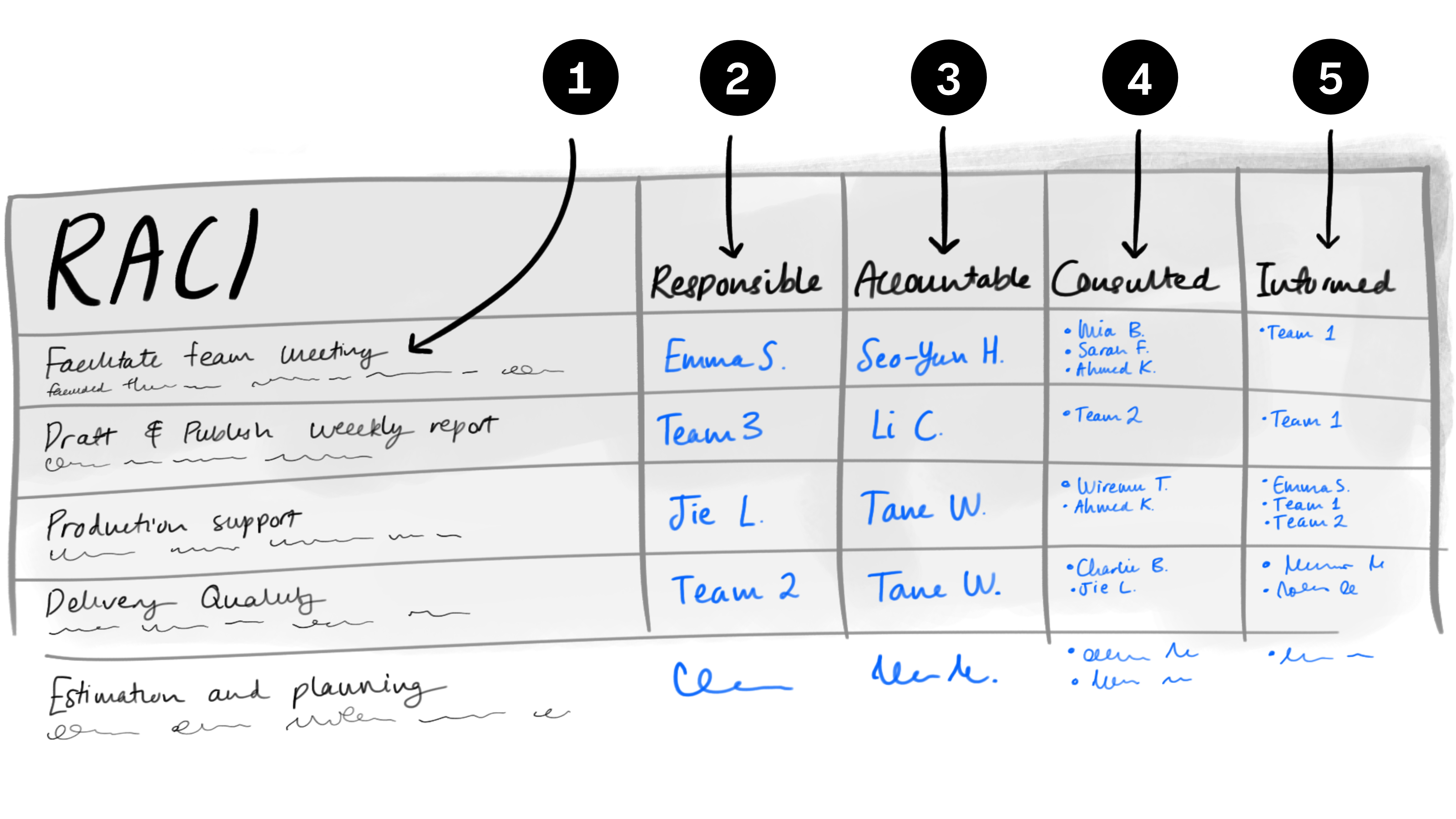RACI
Clarify who should be involved.

The RACI has a column listing activities, then four columns for “Responsible”, “Accountable”, “Consulted”, and “Informed” listing the names of people with that association to that activity.
Elements
- Activity: the name of the item being assigned, along with a description of the activity, task, or output if necessary to define the scope.
- Responsible: who completes the activity.
- Accountable: who ensures that the activity is completed properly (think: who’s to blame if this goes south?)
- Consulted: who might provide input to assist in the completion of the activity?
- Informed: who needs to know that the activity has been or will be completed?
What it is
A RACI — pronounced racy — is a diagram that clarifies who should be involved in a set of activities, and the level at which each should be involved. RACI stands for Responsible, Accountable, Consulted, and Informed.
There are plenty of variants — CLAM being the most cleverly named — but all of them list activities and define the types of relationship that individuals or teams have to those activities.
When to use it
- Use a RACI Chart when there is confusion about what people should be doing. It’s a super simple way to make sure that all are clear on what they should be doing.
- Use a RACI Chart when starting a new team to reduce the chance of individuals stepping on each other’s toes.
How to use it
- Create a five-column table and label the columns from left to right Activity, Responsible, Accountable, Consulted, and Informed.
- Make a list of activities or tasks related that you are trying to clarify and record them in the first column, Activity, one to a row.
- In a group, begin with the first row and answer the following questions regarding that activity. Move on if the group fails to reach consensus.
- Who actually completes this activity? Record this individual or team in the Responsible column.
- Who is to blame if this activity is not completed or is completed incorrectly? Record this individual in the Accountable column.
- Who will need to provide input for this activity to be completed correctly? Record these people or teams in the Consulted column.
- Who will need to be notified when this activity is complete? Record these people in the Informed column.
- Repeat this process for each activity in the Activity column, looping back to fill in any blanks once consensus is achieved.
- Share it! Put the final matrix in a shared location so everyone knows who’s who.
Rules for use
- Activities must be concrete actions that a person or team can undertake. Vague or abstract activities create confusion.
- No more than one person can be accountable for each activity: accountability must lie with a single individual.
- No one can be both accountable and responsible for an activity. Note: in rare cases someone (e.g., a CEO) may break this rule.
- Only one person or one team can be responsible for an activity.
- The Responsible and Accountable columns must be filled for every activity. The Consulted and Informed columns are optional, but are usually filled as well.
- No individual or team can hold more than one relationship with an activity, e.g., no one can be both responsible and consulted, or both accountable and informed.
Guidelines
- Tackle it as a team! The power of a RACI is to create consensus across a group of people regarding who is responsible for what, ergo doing it solo undermines the key benefit.
- Generally, individuals are either consulted or informed, because consulting by its nature involves informing as well.
Tips and tricks
- Define the different columns clearly at the start of the exercise! You might be surprised at how many people get confused by the difference between Accountable and Responsible.
- Outputs are easy. If you are finding it hard to come up with concrete activities, then start with some of the key outputs your team produces (code, documentation, reports, etc.) as activities and build from there.
- Stuck? If it isn’t clear who owns a thing, just move on and loop back to it later. Either the task itself is confusing, or you need time to discuss and clarify.
- Make the Informed column less of a perceived demotion: put someone everyone considers important (think CEO important) into this column to help people to realise that informed isn’t a bad thing to be.
- Clarity on how consultation occurs can also be helpful. For important activities, clarify the expectations of the Consulted and Informed parties.
- If you are working with a large list of activities and need some Excel sorting powers, try the more complex RACI Chart layout: keep activities where they are, but make a column for each person or team and put their relationship type (R, A, C, or I) into the intersecting row.
Common issues
- Resistance to role. Some individuals will resist being assigned to the Informed column because it means that they will not be consulted. You may get push back even if Informed is the right place for them.
- Lack of consensus. Sometimes you simply need someone higher up the chain to make a decision as to who owns an activity.
- Missing the mundane. It is easy to focus on the big and flashy activities and not to clarify the everyday activities.
- Informal authority. We all know the person who is in no way responsible or accountable for anything to do with a project, and yet they hold obvious and undefined power. Use the RACIto clarify their roles and responsibilities.
Last updated .